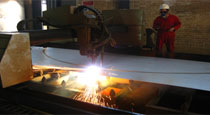
Transfer Facility
An overhead crane, commonly called a bridge crane, is a type of crane found in industrial environments. An overhead crane consists of parallel runways with a traveling bridge spanning the gap. A hoist, the lifting component of a crane, travels along the bridge. If the bridge is rigidly supported on two or more legs running on a fixed rail at ground level, the crane is called a gantry crane (USA, ASME B30 series) or a goliath crane (UK, BS 466).

Bending

Welding
Submerged arc welding (SAW) is a method in which the heat required to fuse the metal is generated by an arc formed by an electric current passing between the electrode and the work piece. A layer of granulated mineral material known as submerged arc welding flux covers the tip of the welding wire, the arc, and the work piece. There is no visible arc and no sparks, spatter or fume. The electrode may be a solid or cored wire or a strip.

